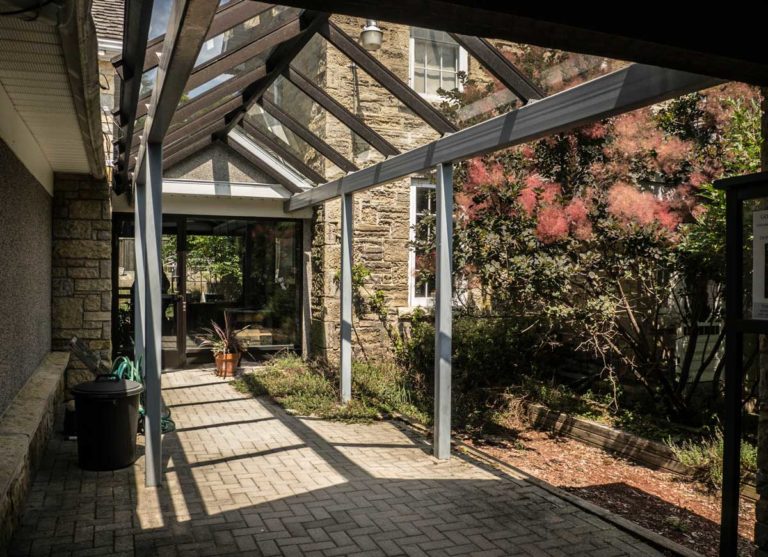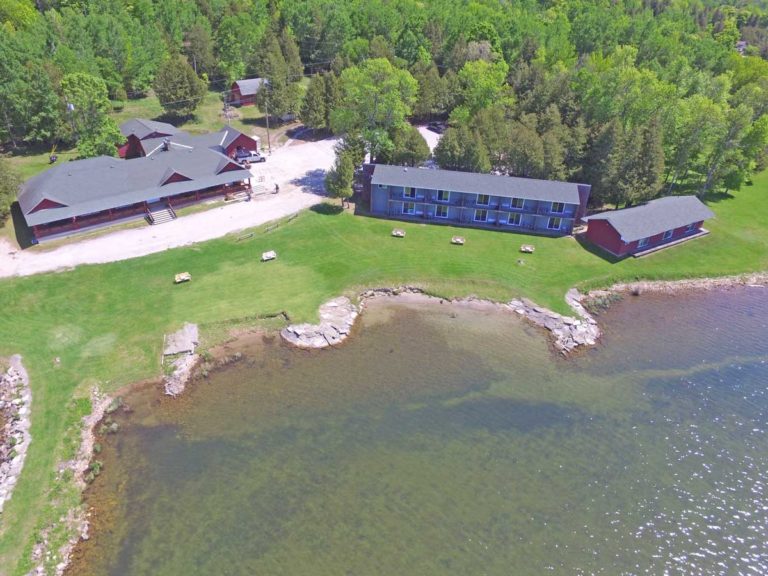Ice Lake
Keen fishermen may find:
- Perch
- Pike
- Bass

A shallow, reedy, but surprisingly extensive lake located between Kagawong and Gore Bay. Ice Lake got its name for being the first lake on Manitoulin to freeze each winter and the first to de-ice in the spring.
Compared to such larger, deeper lakes such as Kagawong and Manitou, which don’t ice over until the last week of December or the first of January, Ice Lake firms up well before Christmas, “In recent years it’s been frozen by December 5,” says Bill Baker, who lives at the north end of the lake.
Just because it freezes quickly however, doesn’t mean the ice is safe to travel on. “It’s a lake we don’t use that much in the winter,” remarks Mr. Baker. “There are pockets where it’s not always solid.” He theorizes that gas released by the vegetative bottom is likely accountable for the soft patches.
This hasn’t stopped people from venturing out onto the ice over the years. Mr. Baker remembers seeing “a car out there when I was a kid, towing a couple of skiers.”
Most people are wary of the ice, though. “Old people have referred to teams of horses going through the ice,” says Mr. Baker, adding that his own mother, Ethel Prior talked about two young fellows who drowned in Ice Lake while skating.
The northern and southern portions of the lake are distinct, separated by a peninsula. The northern half is fairly broad and contains two islands (the larger of which, Goat Island, has had a baldheaded eagle nesting on it for the past few years), but extremely shallow throughout, just four feet deep on average; the southern portion is narrower; but twice as deep. It’s a weird shaped lake; the best thing I can liken it to is a dog’s leg.
It was fitting, then, that I brought my pooch along when I decided to do a tour of the lake. It was a breezy day, and I figured he’d be good for a ballast.
I originally planned to put my canoe in at the north end of the lake, where Highway 540 crosses a causeway and there’s a small pull-over spot, but after speaking with Mr. Baker, I learned that the real public launch for the lake is in the southern part.
So instead of following Highway 540 to the tip of the lake, I turned off on Robertson Road. This intersection was once the hub of the community of Ice Lake. While the community was never very big, it still appears on the Turners of Little Current map, and at one time there was a general store here, as well as a post office, which first opened in 1903. Farther down Robertson Road, a stone schoolhouse still stands, engraved with the date 1904 which is the community hall now. If you go the other way from that intersection, north, the roadway is called Beange Road and leads straight to Burt’s Country Meats, a unique organic farm abattoir and retail operation run by a husband and wife who successfully repurposed the family farm over a quarter century ago.
Before I got to the schoolhouse, however, I was arrested by a different stony sight: a farmer’s field humped with half a dozen large, tidy, circular rock piles. I’d never seen so many rock piles, or such symmetrical, aesthetically pleasing ones, in any one place, and I used to live in Rockville.
To reach the public launch, continue past the schoolhouse and then turn right (west) on Douglas Road. When it bends to the south, continue straight to the water.
There’s not much here, just a couple of resident boats (seemingly rentals), some reeds, and a spot to put your boat in the lake. While people have been known to back trailers into the water, most just bring 14-footers that they can slide in by hand and slap a motor on, as the water is quite shallow and the bottom rather soft.
Me, I slid my 16-foot motor-less mode of transport in, told my “ballast” to jump unto the front, and off we went. It was a beautiful evening, but breezy, as I had expected. I decided to head northwest, into the wind, so that coming back would be a, well, breeze.
I aimed for something out in the middle of the lake that appeared to be either a sizable deadhead or an extremely large bird. I t turned out to be an empty 20-pound propane tank, with a small tern perched on top. I have no idea what the tank was there for, presumably marking a rock or hazard of some sort. My dog spooked the tern, and it took off, V-tail and bent wings flashing through the air.
The water was a murky, greenish colour, and at times, even well out from shore, I would look down and realize I was stirring weeds with my paddle tip. At other times, I could easily make out the mucky or pebbly bottom, even through the opaque water. And I was in the deep half of the lake.
Mr. Baker told me that the lake bottom in the shallower, northern end of the lake is actually deeded land. “An American company had the deed, something to do with some mineral in the lake,” he explained, adding that when he was on council for Gordon Township, “it came up for sale for taxes owing.” The municipality decided that nobody should own the bottom of the lake.
Me, I wondered: who would want to own the bottom of this lake? Is there a business possibility in bottling methane gas or something?
The top of the lake, now that was different. Looking around at Ice Lake from my canoe, I found the surface and scenery quite pleasing.
My mutt did too. He particularly liked the fake duck that we found. I’d call it a decoy, except that it was just a grey blob in the vague shape of a duck; it certainly wasn’t a hand carved, intricately painted facsimile. Still, my dog became briefly wound up over the plastic ducky and threatened to tip the canoe.
He also got a bit-wound up over the catamaran that zipped past us at one point, brightly coloured sail puffed in the wind, I paddled as close as I could to snap a picture, and my dog thought that this meant he might have a chance to jump aboard the sailboat. “Lie down,” I ordered, pointlessly. “Sit down,” I begged. “Be a good ballast,” I implored.
Instead the mutt remained, of course, perched on all fours, body straining forward, ears perked up and flapping around crazily in the wind.
This slick-looking catamaran was bearing down on us, big colourful sail puffed professionally in the breeze. Here we were, zigzagging around in a scratched-up canoe. My sail, such as it was, being this recalcitrant canine.
Nearby places to stay, eat and play
Gore Bay Museum
Gore Bay Boardwalk Trail
Codmothers
The Inn at Gore Bay
Fishing boats were scarce on the lake while I was out there paddling around with my ballast/sail in the bow, but I did encounter one just as we were leaving. They were putting their aluminum boat into Ice Lake just as me and the mutt were taking our Kevlar craft out.
When I asked the fishing boat individuals what there was to get in Ice Lake, he responded: “There’s bass, perch, pike and barbus.”
I thought about that for a minute. I recognized most of the words, but not all. Finally, I ventured: “Um what’s a barbus?” By the time I asked the question I was picturing some kind of exotic, great tasting fish that only exists in the shallow waters of Ice Lake.
Bob, one of the anglers, said “A catfish”, “Oh” I said.
I’ve since looked up “barbus” is my dictionary, and couldn’t find it, but I did find “barbate”. My dictionary says it means “tufted with long hairs,” so maybe “barbus” really is a catfish.
I didn’t stick around long enough to find out if they caught a bass or perch or pike or barbus, but it was interesting to me to find out that people really do come here to fish. And sail. And do other summer things including staying at the lake’s single resort, Evergreen Resort.
Indeed, Ice Lake has something for nearly everyone, young and old. There is a kid’s camp something nearly unique on Manitoulin, called Strawberry Point Christian Camp. It’s access off Robertson Road which is down the east side of the lake from Highway 540.
It struck me as a bit ironic that this lake, named for its propensity to freeze up quickly, is mostly avoided in the winter because of the bad ice, while in the summer months a lot of people evidently enjoy its warm shallow waters.
I know my dog did. It took me forever to coax him from the canoe and convince him it was time to go home.




